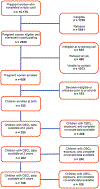The relationship of prenatal acetaminophen exposure and attention-related behavior in early childhood
- PMID: 38199313
- PMCID: PMC11018143
- DOI: 10.1016/j.ntt.2024.107319
The relationship of prenatal acetaminophen exposure and attention-related behavior in early childhood
Abstract
Acetaminophen is currently the only analgesic considered safe for use throughout pregnancy, but recent studies indicate that prenatal exposure to acetaminophen may be related to poorer neurodevelopmental outcomes. Multiple studies have suggested that it may be associated with attention problems, but few have examined this association by trimester of exposure. The Illinois Kids Development Study is a prospective birth cohort located in east-central Illinois. Exposure data were collected between December 2013 and March 2020, and 535 newborns were enrolled during that period. Mothers reported the number of times they took acetaminophen at six time points across pregnancy. When children were 2, 3, and 4 years of age, caregivers completed the Child Behavior Checklist for ages 1.5-5 years (CBCL). Associations of acetaminophen use during pregnancy with scores on the Attention Problems and ADHD Problems syndrome scales, the Internalizing and Externalizing Behavior composite scales, and the Total Problems score were evaluated. Higher acetaminophen exposure during the second trimester of fetal development was associated with higher Attention Problems, ADHD Problems, Externalizing Behavior, and Total Problems scores at ages 2 and 3. Higher second trimester exposure was only associated with higher Externalizing Behavior and Total Problems scores at 4 years. Higher cumulative exposure across pregnancy was associated with higher Attention Problems and ADHD Problems scores at ages 2 and 3. Findings suggest that prenatal acetaminophen exposure, especially during the second trimester, may be related to problems with attention in early childhood.
Keywords: Acetaminophen; Attention; CBCL; Early childhood; Paracetamol; Prenatal.
Copyright © 2024 The Authors. Published by Elsevier Inc. All rights reserved.
Conflict of interest statement
Declaration of competing interest The authors declare the following financial interests/personal relationships which may be considered as potential competing interests: Senior author serves on Neurotoxicology and Teratology Editorial Advisory Board - S.L.S.
Figures






References
-
- Achenbach T, Rescorla L, 2000. Child Behavior Checklist for Ages 1 ½ - 5. University of Vermont, Burlington, VT.
MeSH terms
Substances
Grants and funding
LinkOut - more resources
Full Text Sources
Medical

